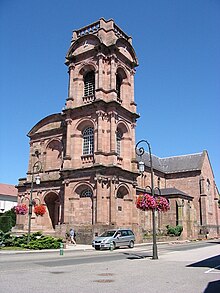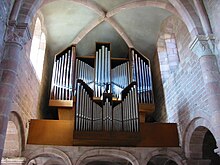Etival Abbey
The Saint-Pierre d'Étival Abbey , in Étival-Clairefontaine in the Vosges department in France , was founded as a Benedictine monastery around the middle of the 7th century . Some historians also assume that it was founded even earlier. In 880, Etival was converted into a canons' monastery, which existed until 1147. Then it became a Premonstratensian monastery . It was dissolved in the course of the French Revolution .
The monasteries Étival in the west, Senones in the east, Saint-Dié in the south, Bonmoutier in the north and Moyenmoutier in the middle form the so-called Croix Sacrée de Lorraine (the Holy Cross of Lorraine) or the "Croix Monastique de Lorraine" (the Monastery Cross of Lorraine).
Benedictine abbey and monastery
Leudinus Bodo , son of a wealthy landlady and bishop of Toul from 667 to around 669 , initiated the foundation of a monastery in the Meurthe valley , near the island of Chiarafontana (later Clairefontaine), by giving land to Benedictine monks there for them there the church district Étival ("Ban d'Étival") and a monastery were able to establish. Even before he was promoted to Bishop of Toul, he had founded the Bonmoutier convent around 650. The monastery was initially a dual monastery, with canons and choir women.
An uproar among the canons in 880 led King Charles the Fat to donate the monastery and the entire district around Étival to his wife Richardis . She appointed a dozen canons and a provost , subordinated Étival in 881 to the Andlau Abbey in Alsace, which she founded in the same year (where she herself became abbess in 887), and became the patroness and benefactor of Étival. The monastery was subordinate to the Abbess von Andlau, who until at least 1685 had the right to appoint the provosts or abbots of Etival.
Between 912 and 920 the monastery was devastated several times by Magyar raids.
Premonstratensian Abbey
In the second quarter of the 12th century, the members of the foundation refused to join the new order of the Premonstratensians with its stricter rules. Nevertheless, in 1147 Abbot Conrad invited the Premonstratensians of Flabémont to come to Étival and take over the monastery. The reluctant canons went to Autrey .
The Premonstratensian canons began to expand the large and impressive monastery complex as early as the second half of the 12th century, which was expanded over the course of the following 6 centuries and thus bears witness to the architectural development from the 12th to the early 18th century. The monastery was fortified with fortifications that included the surrounding watercourses. These facilities were largely destroyed during the French Revolution in 1789 and World War II. (You can still get an impression of it today in the courtyard of the canons and the former abbot's apartment.)
In 1309, Duke Theobald II of Lorraine gave the abbey high, middle and low jurisdiction in the entire Étival district. (The future Abbot of Étival and historiographer of the Premonstratensian Order, Charles Louis Hugo , claimed 400 years later that the abbey had been granted quasi-episcopal rights.)
Twice, in 1569 and 1646, the monastery suffered considerable damage from major fires, but was restored on each occasion.
Étival became one of the largest monasteries in Lorraine and reached its peak under the abbots Siméon Godin and Charles Louis Hugo, the historiographer of the order appointed by the General Chapter in 1717 . Abbot Hugo built the abbey palace. A bitter dispute between Abbot Hugo and the Bishop of Toul over the exemption of the monastery heralded the end of this heyday. The conflict carried on to Rome, where Cardinal Secretary of State Nicolò Maria Lercari supported the position of abbot. Since the bishop did not give in, Pope Benedict XIII. Abbot Hugo became Bishop of Ptolemais on December 15, 1728 in partibus . Charles Louis Hugo died in 1739 and no successor was appointed. Instead, the Bishop of Toul finally subordinated the monastery to his diocese in 1747.
resolution
As a result of the French Revolution of 1789, the monastery was dissolved. In 1790 there were still ten nuns and ten monks living in Étival, as well as eight nuns and five clergymen who worked in neighboring parishes. They left Étival for good in 1792.
Monastery church
The three-aisled monastery church "Notre Dame" made of red sandstone is a masterpiece of Romanesque architecture in the Vosges and was declared a historical monument in 1986. Its style is similar to that of the cathedral in Saint-Dié-des-Vosges (Sankt Didel), which was also destroyed by Germans in 1944. It was built around 1200 by the canons on the site of an earlier chapel and in the 16th century it was embellished with Gothic building elements and one of St. Richardi's consecrated chapel expanded. The portal dates from the Renaissance , the facade (based on plans by the premonstratensian Nicolas Pierson, who was also the architect of the church of Pont-à-Mousson) from the time of Abbots Siméon Godin and Charles Louis Hugo at the beginning of the 18th century, as well the north side was rebuilt. In addition to the Saint-Dié cathedral, the Étival church is the only one in the Vosges with a monumental 18th century facade.
German occupation soldiers blew up the church on the evening of November 9, 1944. It was gradually restored in the 1950s. In doing so, it lost something of its original majesty, as the tower could no longer be built in its old location, but had to be placed on the other side of the western front and one floor had to be left out.
The church is open to visitors on Sundays from 2 p.m. to 5 p.m. and on all other days from 10 a.m. to 5 p.m.
List of Premonstratensian abbots from Etival
- Gilbert (1146-1150)
- Hugo I. (1150-1158)
- Ramband (? -April 1168)
- Gautier (or Valterus) (1168–1176 or 1177)
- Garnier (1176 or 1177–?)
- Géraldus (? -?)
- Hamandus (? -?)
- Albert (? -?)
- Nicolas (? -?)
- Vidric (? -?)
- Hugo II (-1222)
- Etienne (? -?)
- Richier (? -?)
- Lisiard (? -?)
- Thierry (? -?)
- Philippe (? -?)
- Gérard de Ville (1289-1310)
- Simon (1310-1312?)
- Gérard de Ville (1313-1328)
- Dominique de Rambervillers (1328-1337)
- Albert de Onville (1337-1337)
- Thierry de Moulin (1337 / 38–1341)
- Pierre I (1341 - January 15, 1356)
- Dominique de Nancy (1356-1387 / 88)
- Vuillaume de Malhoste de Lunéville (1388? –1421)
- Dominique de Midrevaux (1421-1450)
- Gérard d'Essey (1450 - February 18, 1481)
- Pierre de Corcieux (1481 - March 4, 1485)
- François Fagnozel (Fagnosel, Fagnosey) (1485 - April 15, 1515)
- Jean Féal (1515 - November 13, 1516)
- Didier Banviet (1516-1544)
- Jean Banviet (1544–1554)
- Antoine Nicolas Saffrois (February 3, 1554 - February 11, 1554)
- Jean de Maisières (1554 - May 11, 1581)
- Antoine Doridant (1581–1609)
- Didier Frouard (1609 - May 24, 1617)
- Jean Frouard (1619–1655)
- Hilarion Rampant (1655 - March 12, 1663)
- Epiphane Louis (1663 - September 23, 1682)
- Siméon Godin (1682 - October 4, 1721)
- Charles Louis Hugo (1722 - August 2, 1739)
literature
- André Petitdemange u. a .: Senones, Moyenmoutier, Étival: Pays d'abbayes en Lorraine , Office de tourisme du pays des abbayes, Senones, 2007, ISBN 978-2-9529604-0-3 (French)
- Peter Volkelt / Horst van Hees: Reclams Art Guide France III: Lorraine, Ardennes, Eastern Champagne , Stuttgart 1983: Philipp Reclam jun., ISBN 3-15-010319-3 , p. 245 ff.
Web links
- La route des 3 abbayes (French)
- The street of the 3 abbeys. (PDF file; 952 kB)
Coordinates: 48 ° 21 '52.2 " N , 6 ° 51' 58" E

